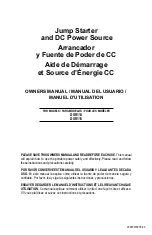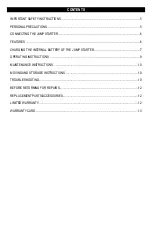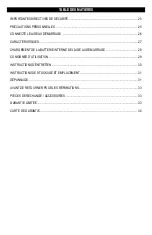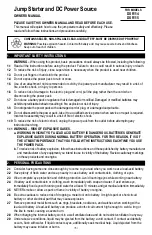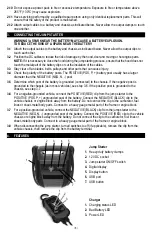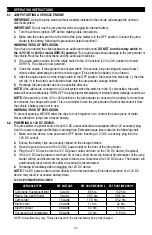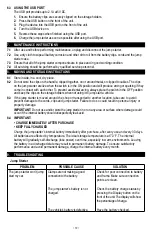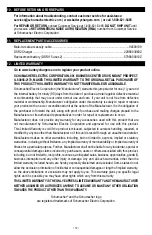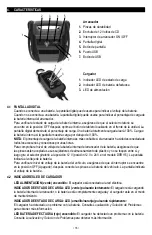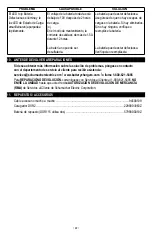
• 9 •
6. OPERATING INSTRUCTIONS
6.1
JUMP STARTING A VEHICLE ENGINE
IMPORTANT: Using the jump starter without a battery installed in the vehicle will damage the vehicle’s
electrical system.
IMPORTANT: Do not use the jump starter while charging its internal battery.
1. Turn the vehicle’s ignition OFF before making cable connections.
2. Make sure the rotary switch on the front of the jump starter is in the OFF position. Connect the jump
starter to the battery, following the precautions listed in section 3.
WARNING! RISK OF EXPLOSION.
If you have connected the clips backward, an audio alarm will sound. DO NOT turn the rotary switch to
the 12V (12V or 24V for model DSR115) position. This could cause serious damage to the jump starter or
the vehicle. Reverse the connections and the audio alarm will stop.
3. If no audio alarm sounds, turn the rotary switch to the 12V position (12V or 24V position for model
DSR115). The clips are now powered.
4. Crank the engine. If the engine does not start within 3-8 seconds, stop cranking and wait at least 1
minute before attempting to start the vehicle again. (This permits the battery to cool down.)
5. After the engine starts, turn the rotary switch to the OFF position. Disconnect the black clip (-), then the
red clip (+) in that order, and clip them back onto the jump starter storage holders.
6. Recharge the jump starter as soon as possible after use.
NOTE: If the cables are connected to a 24 volt system when the switch is in the 12 volt position, the audio
alarm will sound continuously. TURN OFF the jump starter immediately or internal battery damage could occur.
NOTE: If the switch is in the 12V or 24V position or the jump starter is connected to a battery for more than
five minutes, four beeps will sound. This is a reminder to turn the jump starter off and/or disconnect it from
the vehicle’s battery when not in use.
WARNING! RISK OF EXPLOSION.
To prevent sparking, NEVER allow the clips to touch together or to contact the same piece of metal.
Never attempt to jump start a frozen battery.
6.2
POWERING A 12V DC DEVICE:
The jump starter is a power source for all 12V DC accessories that are equipped with a 12V accessory plug.
Use it for power outages and fishing or camping trips. Estimated usage time is listed in the following chart.
1. Make sure the device to be powered is OFF before inserting a 12V DC accessory plug into the
12V DC socket.
2. Ensure the battery clips are securely clipped on the storage holders.
3. Open the protective cover of the 12V DC power outlet on the front of the jump starter.
4. Plug the 12V DC device into the 12V DC power outlet, and turn on the 12V DC device (if required).
5. If the 12V DC device draws more than 15A or has a short circuit, the internal circuit breaker of the jump
starter will trip and disconnect the power to the device. Disconnect the 12V DC device. The breaker will
automatically reset a short time after an overload is disconnected.
6. Recharge immediately after unplugging the 12V DC device.
NOTE: The DC power outlet is wired directly to the internal battery. Extended operation of a 12V DC
device may result in excessive battery drain.
12V DC ESTIMATED RUN-TIMES
APPLIANCE TYPE
EST. WATTAGE
EST. RUN TIME DSR114 EST. RUN TIME DSR115
Cell phone, fluorescent light
4 watts
66 hrs.
132 hrs.
Radio, fan, depth finder
9 watts
29.3 hrs.
58.6 hrs.
Camcorder
15 watts
17.6 hrs.
35.2 hrs.
Electric tool
24 watts
11 hrs.
22 hrs.
Electric cooler
48 watts
5.5 hrs.
11 hrs.
Car vacuum, air compressor
80 watts
3.3 hrs.
6.6 hrs.
NOTE: Actual time may vary. Times are based on the internal battery being fully charged.

